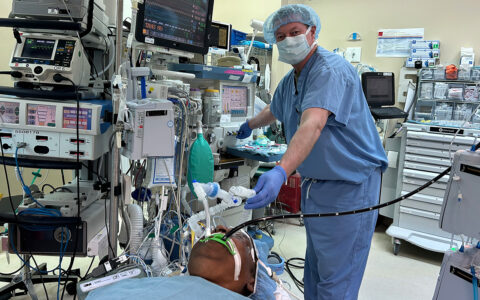In the largest study of its kind, researchers have characterized the exocrine pancreas, highlighting changes during aging and diabetes, with detailed histology displaying patterns of fibrosis, angiopathy, metaplasia and adiposity.
The team’s findings, published in Diabetes, reflects a growing interest in the exocrine pancreas, an often-overlooked segment of the organ that is typically associated with digestion.
“It’s getting more attention that there are significant changes in the exocrine pancreas in diabetes but, until now, they haven’t been well-studied or understood,” said Jordan J. Wright, M.D., Ph.D., an assistant professor of diabetes, endocrinology and metabolism at Vanderbilt University Medical Center, and the study’s first author.
Dual Roles, More Resources
The pancreas comprises two structurally related compartments: the endocrine and exocrine. The endocrine pancreas supports glucose homeostasis and is surrounded by exocrine tissue that interfaces with the gastrointestinal tract.
“The exocrine pancreas can be hard to study because it’s full of digestive enzymes,” Wright explained. “When someone passes away, it immediately starts degrading.”
Now, thanks to improved procurement methods, the researchers were able to study well-preserved exocrine tissues from 119 deceased donors: 74 without diabetes, 20 with Type 1 diabetes (T1D) and 25 with Type 2 (T2D). The T1D cohort included adolescents, making the findings broadly applicable.
“Over the past decade, there have been improved resources to get tissues that are really surgical quality,” Wright said.
Databases contributing to the research were provided by Human Pancreas Analysis Program, the Network for Pancreatic Organ Donors with Diabetes and the Vanderbilt Pancreas Biorepository. Vanderbilt’s biorepository was established and is overseen by two of the study’s senior authors, Al Powers, M.D., and Marcela Brissova, Ph.D., of VUMC. A third, Adel Eskaros, M.B.B.S., Ph.D., contributed much of the histology.
“That’s what really allowed us to do this study, which was the largest of its kind,” Wright said.
Abnormalities are ‘Normal’
Seeking common features of a healthy exocrine pancreas, they looked at the samples from donors without diabetes.
“As we started looking at this, we came to the realization that the ‘normal’ pancreas isn’t that normal. Abnormalities are surprisingly common,” Wright said.
They found that cellular differentiation (acinar-to-ductal metaplasia) and adiposity increased with age and BMI. Angiopathy also increased with age among donors without diabetes.
“Obviously there are things that are changing with age and things that are not.”
“Specific angiopathic features, like blood vessel thickening, increased strikingly with age,” Wright said. “Features that we thought would increase but didn’t were fibrosis and acinar atrophy. So obviously there are things that are changing with age and some that are not.”
The team also found connections between structural changes in the acinar tissue according to age and BMI, which Wright believes could be confirmed with a larger sample size.
Focus on Diabetes
When the researchers trained their microscopes on diabetic samples, they found significant fibrosis and angiopathy.
“One striking thing is that both T1D and T2D have exocrine fibrosis,” Wright said. “We’d previously reported that in T1D, but it hasn’t really been discussed in T2D. We went further to look at differences in the patterns, which we think may reflect differences in the pathogenesis.”
The team found fibrosis around ducts and vessels in T1D samples. In T2D, the fibrosis was more diffuse.
“I think this supports the idea that the ducts may be involved early on in T1D,” Wright said.
Among T2D exocrine tissues, they found minimal changes in cell populations. There was no change in the number of pancreatic adipocytes, a minimal increase in T cells, and no change in the quantity of endothelial cells or macrophages, as compared to age- and sex-matched non-diabetic samples. In contrast, T1D tissues had significantly fewer adipocytes.
Addressing Exocrine Changes
Wright and colleagues previously demonstrated that the exocrine pancreas is smaller in T1D, including in children. While it’s too early for their newest findings to be applied to patient care, Wright speculates changes in the exocrine pancreas may underlie perplexing symptoms in patients with diabetes.
“We may need to think about exocrine insufficiency as a driver of symptoms in these patients. A lot of patients with T1D have longstanding upset stomach or similar symptoms that are hard to pin down. Having a lower threshold to test for exocrine insufficiency would be good.”
Toward this aim, Vanderbilt pediatric endocrinologist Daniel Moore, M.D., Ph.D., is leading a study to determine whether replacing pancreatic enzymes in children might ameliorate symptoms.
“We may need to think about exocrine insufficiency as a driver of symptoms.”
“We know people with diabetes secrete fewer pancreatic enzymes. It’s possible that treating that earlier than we already do might benefit diabetes control,” Wright said.
The researchers are also looking to understand mechanisms behind the fibrosis and angiopathy observed in the diabetic tissue samples.
“Clearly the blood vessels of the pancreas are being affected. We don’t really understand how yet. That’s an important area of future study,” he said.




